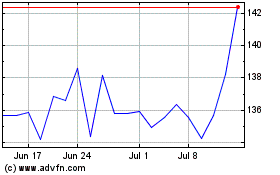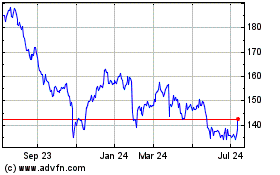By Ted Mann
Jet-engine maker Pratt & Whitney had a problem this summer,
one familiar to anyone who has assembled a do-it-yourself bookcase:
Not all the parts were in the box.
Production on the company's engines--including a new generation
spawned by a $10 billion investment--ground almost to a halt for
nearly a month in August as problems with the launch of a
custom-built UPS facility for engine parts cascaded into a
crisis.
Pratt, a unit of United Technologies Corp., had contracted with
United Parcel Service Inc. in an effort to streamline its supply
chain as it prepared to ramp up manufacturing. Pratt has a backlog
of more than 7,000 orders for the more fuel-efficient commercial
engines, and plans to increase annual output to more than 500 by
2018 from dozens this year.
UPS said last year it would set up a logistics center in
Londonderry, N.H., to take in parts from Pratt's suppliers, package
them into kits holding about 8,000 parts, and ship them to Pratt
factories for assembly by company's machinists.
But the 130-person logistics facility was beset by problems
after it opened in July, said people familiar with the operation,
slowing assembly to a crawl. Some engine kits arrived at Pratt's
engine centers in Middletown, Conn., and West Palm Beach, Fla.,
without all the required require parts.
The union for the machinists that assemble Pratt's engines said
some parts arrived dirty and damaged. That forced workers to
scrounge together parts for a single engine from multiple kits,
ultimately slowing downassembly for weeks this summer.
"Kits are coming in with wrong parts, and some of the parts
don't even fit in the allocated slot! It's almost like trying to
put a square peg into a round hole!," a union representative wrote
in a newsletter to members last month.
After the August disruption, Pratt says parts are now flowing as
intended through the logistics center, and that engine output is
back to normal.
"UPS personnel have worked closely with the team at Pratt &
Whitney to resolve initial implementation issues, and material is
now flowing to assembly sites at scheduled production volume," a
UPS spokesman said.
Danny DiPerna, Pratt's senior vice president for engineering and
operations, acknowledged "a temporary interruption of material flow
to our factories" this summer, but said the company chalks the
problems up to growing pains.
After the problems emerged, high-rankingPratt executives spent
weeks on the ground in Londonderry, training UPS workers who were
unfamiliar with jet-engine parts and working out kinks in the
companies' inventory software.
The incident highlights the pressure Pratt, which accounts for
22% of United Technologies's $65 billion in annual sales, is under
to keep its operations running smoothly as it begins its engine
ramp-up--and how efforts to streamline a supply chain can
backfire.
"People always ask, 'What's the one thing that keeps you up at
night?' " United Technologies Chief Executive Greg Hayes said last
month. "It's the ramp. The technology, I'm very confident we've got
that right. But you're only as good as your worst supplier. When
you've got 8,000 parts in an engine, one of those parts aren't
there, you're not building an engine."
By turning over its logistics to UPS, Pratt had hoped that it
would eliminate low-value work for its labor force, and avoid
holding extensive inventory on its own books, Mr. Hayes said. The
company will use the new logistics system for all of its engine
models, including for the new F-35 fighter for the U.S. Air
Force.
With its older engines in decline and the new design requiring a
huge increase in manufacturing, Pratt handed off management of
parts and inventory to a highly automated UPS warehouse that it
believes will better cope with a much higher rate of production,
Pratt's Mr. DiPerna said.
"In the grand scheme of things, this took a few more weeks that
we had planned," he said, but the facility will support Pratt's
production for decades.
According to a person familiar with the matter, the companies
regard the union's complaints as sour grapes from labor leaders
whose members had been usurped by UPS's nonunion workforce. Union
officials didn't respond to requests for comment.
The New Hampshire missteps are a stumble for UPS, which has been
building out its supply-chain service business in recent years as
it copes with pressures in its traditional delivery business. While
supply chain is still a small part of UPS's overall business,
making up only about 15% of revenues when combined with the
company's freight division, it is one that executives have touted
as a road to growth and part of the delivery giant's core
business.
Laura Stevens contributed to this article.
Write to Ted Mann at ted.mann@wsj.com
Subscribe to WSJ: http://online.wsj.com?mod=djnwires
(END) Dow Jones Newswires
October 01, 2015 20:26 ET (00:26 GMT)
Copyright (c) 2015 Dow Jones & Company, Inc.
United Parcel Service (NYSE:UPS)
Historical Stock Chart
From Mar 2024 to Apr 2024

United Parcel Service (NYSE:UPS)
Historical Stock Chart
From Apr 2023 to Apr 2024
